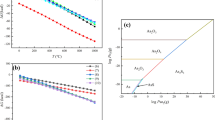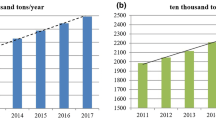Abstract
Because of the widespread presence of arsenic in various smelting waste slags, it not only hinders the recycling and utilization of waste slag, but also causes serious pollution to the ecological environment. In this study, As2O3, the main form of arsenic in non-ferrous metal smelting slag, was used as the research object, and FeCl3 was used as the chlorination agent. As2O3 was selectively chlorinated to low-boiling-point AsCl3 gas which was easy to be volatilized and removed by chlorination roasting. According to the thermodynamic calculation results, the feasibility of FeCl3 as the chlorination agent for selective chlorination and low-temperature volatilization of dearsenization was analyzed. The TG–DTA diagram was analyzed by thermogravimetric experiment, and the mass change, endothermic and exothermic behaviors of the As2O3–FeCl3 system during the linear heating process were studied. The effects of roasting temperature, roasting time, and molar ratio of reactants on the chlorination–volatilization of the As2O3–FeCl3 system were investigated. The optimal chlorination roasting conditions were determined with a roasting temperature of 290–300 ℃, a roasting time of 50 min, and a reactant FeCl3/As2O3 molar ratio of 4:1. The results of this study provided a novel idea for the removal of arsenic from smelting slag and dust, but the mechanism and process conditions of chlorination still need to be further studied and optimized.
Graphical abstract








Similar content being viewed by others
Data availability
All data generated or analyzed during this study are included in this published article (and its supplementary information files).
References
Bothe JV, Brown PW (1999) Arsenic immobilization by calcium arsenate formation. Environ Sci Technol 33:3806–3811. https://doi.org/10.1021/es980998m
Clancy TM, Snyder KV, Reddy R et al (2015) Evaluating the cement stabilization of arsenic-bearing iron wastes from drinking water treatment. J Hazard Mater 300:522–529. https://doi.org/10.1016/j.jhazmat.2015.07.051
Choi WH, Lee SR, Park JY (2009) Cement based solidification/stabilization of arsenic-contaminated mine tailings. Waste Manage 29:1766–1771. https://doi.org/10.1016/j.wasman.2008.11.008
Geldenhuis JMA (2002) Recovery of valuables from flue dust fines. Miner Eng 15:95–98. https://doi.org/10.1016/S0892-6875(01)00197-2
Hu B, Yao JJ, Wang ZY et al (2013) The review of arsenic removal technologies of arsenic ashes. Hunan Nonferrous Met 29:41–44
Jiang PG, Wu PF, Hu XJ et al (2016) Copper slag comprehensive utilization development and new technology is put forward. China Min Magaz 2:76–79
Jiang KX, Wang HB, Wang YF et al (2014) Comprehensive utilization technology of arsenic sulphide slag in copper smelting process. Nonferrous Met Sci Eng 5:13–17. https://doi.org/10.13264/j.cnki.ysjskx.2014.05.00
Liang Y, Li LX, Liao CF et al (2011) Study on de-arsenic from dust of flash smelting furnace. Nonferrous Met (Extract Metall) 1:9–11. https://doi.org/10.3969/J.issn.1007-7545.2011.01.003
Liu SG (2006) A study on comprehensive utilization of the cinder in arsenite preparation. Master's theses. School of Chemical Engineering, Xiangtan University
Mandal BK, Suzuki KT (2002) Arsenic round the world: a review. Talanta 58:201–235. https://doi.org/10.1016/S0039-9140(02)00268-0
Riveros PA, Dutrizac JE, Spencer P (2001) Arsenic disposal practices in the metallurgical industry. Can Metall Quart 40:395–420. https://doi.org/10.1179/cmq.2001.40.4.395
Singh R, Singh S, Parihar P et al (2015) Arsenic contamination, consequences and remediation techniques: A review. Ecotoxicol Environ Saf 112:247–270. https://doi.org/10.1016/j.ecoenv.2014.10.009
Sun GF (2004) Arsenic contamination and arsenicosis in China. Toxicol Appl Pharm 198:268–271. https://doi.org/10.1016/j.taap.2003.10.017
Tan XZ (2010) Practical technology for recycling of metallurgical waste materials. Metallurgical Industry Press, Beijing
Xu ZF, Li Q, Nie HP (2010) Pressure leaching technique of smelter dust with high-copper and high-arsenic. Trans Nonferrous Met Soc China 20:176–181. https://doi.org/10.1016/S1003-6326(10)60035-0
Xue XX, Xing ZX, Cheng GJ et al (2019) Status and Prospect on Research and Development of Arsenic Removal Technology from Arsenic-bearing Materials. Nonferrous Met (Extract Metall) 1:7–11. https://doi.org/10.3969/j.issn.1007-7545.2019.01.002
Xia YJ, Liu J (2004) An overview on chronic arsenism via drinking water in PR China. Thxicology 198:25–29. https://doi.org/10.1016/j.tox.2004.01.016
Xing ZX, Cheng GJ, Yang H et al (2020) Mechanism and application of the ore with chlorination treatment: A review. Miner Eng 154:1–8. https://doi.org/10.1016/j.mineng.2020.106404
Yang D, Sasaki A, Endo M (2019) Reclamation of a waste arsenic-bearing gypsum as a soil conditioner via acid treatment and subsequent Fe(II)single bond As stabilization. J Clean Prod 217:22–31. https://doi.org/10.1016/j.jclepro.2019.01.217
Zhang LQ, Zhou HH, Chen X et al (2021) Study of the micromorphology and health risks of arsenic in copper smelting slag tailings for safe resource utilization. Ecotoxicol Environ Saf 219:112321. https://doi.org/10.1016/j.ecoenv.2021.112321
Zhao HX (2015) Research on solvent extraction separation of arsenic in alkaline solutions. Master's theses. School of Metallurgy and Chemical Engineering, Jiangxi University of Science and Technology (in Chinese)
Zhao Y, Qiu W (2017) Arsenic oxidation and removal from flue gas using H2O2/Na2S2O8 solution. Fuel Process Technol 167:355–362. https://doi.org/10.1016/j.fuproc.2017.07.021
Zheng L, Qiu Z, Tang Q et al (2019) Micromorphology and environmental behavior of oxide deposit layers in sulfide-rich tailings in Tongling, Anhui Province. China Environ Pollut 251:484–492. https://doi.org/10.1016/j.envpol.2019.04.131
Zhou H, Liu G, Zhang L et al (2021) Mineralogical and morphological factors affecting the separation of copper and arsenic in flash copper smelting slag flotation beneficiation process. J Hazard Mater 401:123293. https://doi.org/10.1016/j.jhazmat.2020.123293
Acknowledgements
The authors are especially grateful for the support received from National Key Technology R&D Program (No. 2015BAB19B02) and National Nature Science Foundation of China (No. 51564016).
Author information
Authors and Affiliations
Contributions
Zhenxing Xing was involved in the formal analysis, investigation, methodology, writing—original draft, and writing—review and editing. He Yang contributed to the formal analysis, resources, supervision, and writing—review and editing. Xiangxin Xue was involved in the conceptualization, formal analysis, resources, methodology, and supervision. Pingguo Jiang was involved in the conceptualization, formal analysis, investigation, methodology, and writing—review and editing.
Corresponding author
Ethics declarations
Ethics approval and consent to participate
Not applicable.
Consent for publication
Not applicable.
Competing interests
The authors declare no competing interests.
Additional information
Responsible Editor: Ioannis A. Katsoyiannis
Publisher's note
Springer Nature remains neutral with regard to jurisdictional claims in published maps and institutional affiliations.
Rights and permissions
About this article
Cite this article
Xing, Z., Yang, H., Xue, X. et al. A novel method for dearsenization from arsenic-bearing waste slag by selective chlorination and low-temperature volatilization. Environ Sci Pollut Res 29, 60145–60152 (2022). https://doi.org/10.1007/s11356-021-18231-6
Received:
Accepted:
Published:
Issue Date:
DOI: https://doi.org/10.1007/s11356-021-18231-6




